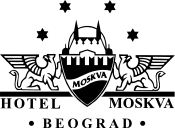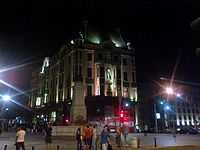Hotel Moskva (Belgrade)
Coordinates: 44°48′46.5″N 20°27′37.5″E / 44.812917°N 20.460417°E
| Hotel Moskva | |
|---|---|
 | |
 Hotel Moskva in August 2012. | |
| General information | |
| Location | Terazije, Belgrade, Serbia |
| Address |
Terazije 20 Belgrade 11000 |
| Opening | 14 January 1908 |
| Technical details | |
| Floor count | 5 |
| Design and construction | |
| Architect | Jovan Ilkić |
| Developer | Karlo Knol |
| Website | |
| Hotel Moskva | |
Hotel Moskva (Serbian Cyrillic: Хотел Москва, pronounced [xɔ̌tɛl mɔ̂skʋa]; English: Hotel Moscow), is one of the oldest hotels currently operating in Belgrade and Serbia.
Apart from being a hotel, Hotel Moskva is one of the most recognizable Belgrade landmarks, a valuable architectural monument placed under governmental protection since 1968. Originally operating as an inn within the multipurpose Palace Rossiya, whose almost 3-year construction and January 1908 opening represented a major investment of the Russian Empire in the Kingdom of Serbia economy, Hotel Moskva eventually expanded its facilities to take up the entire palace.
Location
Hotel Moskva is located on the Terazije square, core of Belgrade's downtown, administratively part of the Stari Grad municipality. It lies at the intersection of three streets: Terazije, Prizrenska, and Balkanska. Location on top of Terazijska Terasa provides a wonderful skyline view of Novi Beograd, across the Sava river.
Apart from other commercial buildings in the vicinity, two other hotels, Balkan and Kasina, are located right across Prizrenska Street and Terazije, respectively. Points of interest in hotel's immediate vicinity are Palace Albania and the Terazije fountain, built in 1860, which is the administratively declared center of Belgrade.
History

In the early 1900s, Svetozar Vukadinović, owner of the Velika Srbija inn located in central Belgrade, the capital of Kingdom of Serbia, traveled to the Russian Empire looking for investors willing to finance his business plan of building a luxurious multipurpose palace in place of his inn. He managed to get some interest from Roman Ivanovich Poitzl of the Rossiya insurance company and in 1905 they requested architectural design proposals for a future palace to be submitted to them. Originally, the design by the Zagreb-based architect Viktor Kovačić got selected, however the Rossiya management decided to go with the Belgrade-based architect Jovan Ilkić's design.
Construction
The construction began in March 1905. Eighty-two wooden beams, 5m in length and 30cm thick, were placed in the palace's foundation followed by 30 wagons of boiling iron in 9-meter long rods, and 10 wagons of hard Ripanj stone. A 2.2m thick concrete panel was then placed over the foundation. The brick-laying hadn't started until spring 1906. The construction work was performed by the civil engineer Karlo Knol and the bricklayers from Crna Trava while the supervising engineer was the project design architect Ilkić himself. Reinforced concrete part of the job was manged by architect Matija Šnajder. The surface of the outer walls from the second floor to the roof was lined with yellowish tiles decorated with green-coloured ornaments. The ceramic lining was brought in from the Zsolnay factory in Pécs, Austria-Hungary that reportedly to this day keeps the casts used to mold it.

Ilkić's design employed a Secessionist style with skillfully incorporated ancient Greek elements, quite daring for that time, giving Belgrade a modern face during the transformation it was undergoing at the turn of the century. The most impressive feature, even at first glance, is the smooth and shiny façade, made of ceramic tiles. Originally, it had 36 rooms, but after many renovations, today it has 132 rooms (of those 40 duplex rooms) and 6 apartments.
Grand opening
The Rossiya palace (in Serbian: Palata Rosija) was finally opened on 14 January 1908 as the biggest privately-owned building in Serbia at the time. Its importance to the country was evidenced in the fact that it was personally opened by Peter I Karađorđević, the King of Serbia.[1] Another part of the opening ceremony was held three days later on the 17th of January with the King's Guard, the Royal Serbian Army's most elite unit, staging a concert.
In addition to Hotel Moskva, the palace housed a kafana, a restaurant, numerous apartments for rent, and the Rossiya insurance company's Belgrade branch headed by Svetozar Vukadinović.
On 23 February 1910, Olympic Committee of Serbia (OKS) was founded and its facilities were in Palace Rossiya. Similarly, the Journalists' club and the Writers' club both moved into the palace.
On 1 October 1923 Poštanska štedionica (Postal Savings Bank) opened its very first counter window at the palace, which in turn was taken over by the National Bank of Yugoslavia in 1938.
During World War II, Gestapo moved into the hotel in 1941, transforming it into its headquarters, and renamed it to Velika Srbija, after the original inn. The headquarter had its own power generators and water sources and was one of the last buildings liberated at the end of war. During German withdrawal in 1944, original master's paintings, silverware and gold-plated utensils which were in the hotel were looted and taken away.
In the post war period, it became a favorite place of the cultural elite. Yugoslav Nobel laureate in literature, Ivo Andrić, had his own table at the restaurant, and poet Vasko Popa was a regular visitor.
In August 2005, the hotel was purchased by the Belize-based off-shore investment fund Netwest Finance represented by Serbian businessman Mile Dragić.[2]
Famous guests
Hotel Moskva is a four star hotel. It is the only hotel in Belgrade that has no room or an apartment number 13. It had over 36 million visitors in the past 100 years, including celebrities like Serbian Field-marshals Živojin Mišić and Petar Bojović, inventors Mikhail Kalashnikov and Albert Einstein, sportists Anatoly Karpov, Garry Kasparov, Carl Lewis, actors like Robert De Niro, Kirk Douglas, Milla Jovovich, Jack Nicholson, Michael Douglas, producers like Alfred Hitchcock, Roman Polanski, Miloš Forman politicians like Nikola Pašić, Rajiv Gandhi, Yasser Arafat, Indira Gandhi, Muammar al-Gaddafi, Richard Nixon and others,singers and tenors like Luciano Pavarotti, Yves Montand, Ray Charles, Bob Geldof writers like Maxim Gorky, Orson Welles, Rebecca West, Jean-Paul Sartre and many others. [3] The pictures of the famous visitors are in a hotel hallways.
Characteristics
It is famed by its restaurant and pastry shop. Cake named after the hotel, Moskva šnit, was introduced in 1974. Originally, hotel had combined French and Serbian cuisine, but today it offers a variety of different cuisines, being one of the rarest in Belgrade to serve vegetarian meals too. There are two restaurants (one with international and other with national cuisine). There is also a snack bar, a famous old fashioned café and a summer garden which is very popular not only with guests, but with Belgraders too.The stocks of hotel Moskva have been rated on the Belgrade Stock Exchange since September 2005.
Future
Present owner (since summer of 2005) of Hotel Moskva is the Swiss company Netwest Finance. They announced a timetable by which hotel is scheduled for reconstruction after Eurovision Song Contest 2008 in May 2008. The works are projected to last for a year, and the hotel is supposed to be renovated, expanded and upgraded one more category, to the five star hotel. Expansion would comprise building of a garage, congressional hall and shopping mall.
See also
References
- ↑ Politika daily, January 22, 2008, p. 23
- ↑ Prodat hotel "Moskva";Kurir, 16 August 2005
- ↑ Glas javnosti